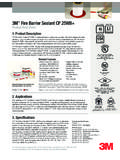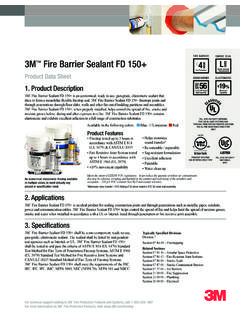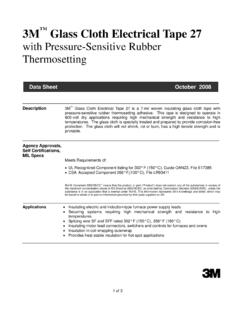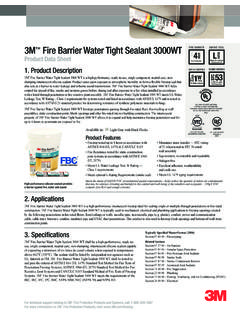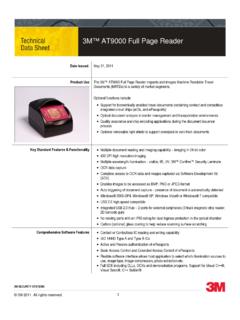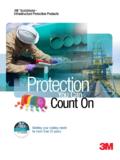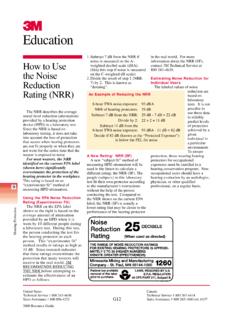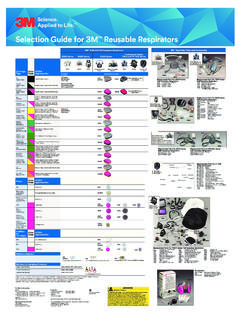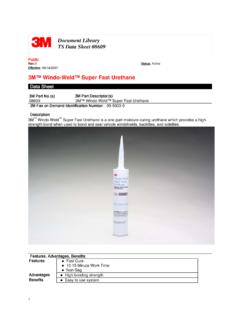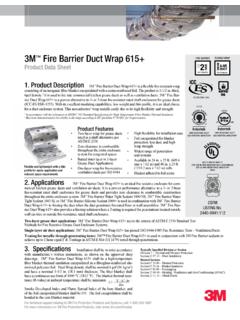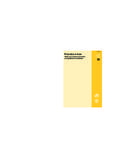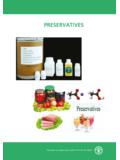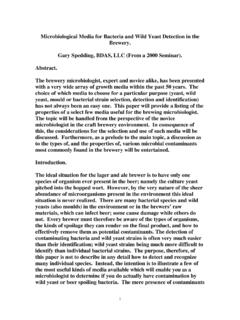Transcription of Comparative Independent Laboratory Evaluation of …
1 1 This paper presents the analytical results for the comparison of the 3M Petrifilm lactic acid bacteria Count Plate method to the CMMEF Chapter 19 and the ISO 15214: Microbiology of food and animal feeding stuffs Horizontal method for the enumeration of mesophilic lactic acid bacteria colony-count technique at 30 C, First edition, 1998-08-01 reference methods. All analyses were conducted at Vanguard Sciences, Inc. (North Sioux City, SD). Comparative Independent Laboratory Evaluation of the 3M Petrifilm lactic acid bacteria Count Plate Method for the Enumeration of lactic acid bacteria in a Variety of Foods and Environmental SurfaceAbstractThe 3M Petrifilm lactic acid bacteria Count Plate method is designed for the detection and enumeration of lactic acid bacteria from select food matrices and environmental surfaces.
2 The 3M Petrifilm lactic acid bacteria Count Plate method was evaluated in a method comparison study according to current AOAC guidelines. The method was compared to the Compendium of Methods for the Microbiological Examination of Foods, 5th Edition (CMMEF) Chapter 19 as well as the ISO 15214: Microbiology of food and animal feeding stuffs Horizontal method for the enumeration of mesophilic lactic acid bacteria colony-count technique at 30 C, First Edition, 1998-08-01 for cold smoked salmon, cream pastry, creamy salad dressing, deli chicken, deli ham, deli turkey, duck p t , pickled herring, kimchi, mayonnaise, mustard potato salad, terrine, yogurt, chicken sausage, pepperoni, cottage cheese, ready to bake pizza and stainless steel (environmental surface).
3 A total of five replicates were analyzed for each of three different levels of microbial contamination for each matrix. An uninoculated level with five total replicates was also analyzed for cream pastry, mustard potato salad, herring, cold smoked salmon and the stainless steel environmental the method comparison study, a paired t-test was used to determine if the mean of the replicate samples at each contamination level for each matrix was different between the 3M Petrifilm lactic acid bacteria Count Plate method, the CMMEF Chapter 19 and ISO 15214 reference methods. The repeatability was also determined.
4 The 3M Petrifilm lactic acid bacteria Count Plate method demonstrated reliability as an accurate alternative to the reference methods for the enumeration of lactic acid bacteria for all 17 food matrices and the one environmental and MethodsTest Product All required 3M Petrifilm lactic acid bacteria Count Plates for the 3M Petrifilm lactic acid bacteria Count Plate Method were provided by 3M Company (St. Paul, MN). Vanguard Sciences (North Sioux City, SD) purchased all matrices: smoked deli ham, pepperoni, deli turkey, deli chicken, chicken sausage, duck p t , herring, cold smoked salmon, cottage cheese, yogurt, creamy salad dressing, terrine, ready to bake pizza, mustard potato salad, mayonnaise, kimchi and cream pastry.
5 Vanguard Sciences provided all general lab equipment and other testing materials. For the reference methods, ISO 15214 and the Compendium of Methods for the Microbiological Examination of Foods (5th Edition), EMD Millipore GranuCult MRS Agar (EMD Millipore Product no. 110660) was utilized. Test Organisms All food matrices were pre-screened for levels of lactic acid bacteria . Cold smoked salmon, cream pastry, herring and mustard potato salad were not naturally contaminated and were inoculated with lactic acid bacteria , see Table 1. The strains that were used to inoculate the selected matrices were grown overnight in MRS broth under anaerobic conditions at 32 C.
6 Serial dilutions of the overnight broths were prepared in peptone water to achieve the desired inoculation 1. lactic acid bacteria strains used to inoculate food matrices without naturally occurring lactic acid StrainMatricesLactococcus lactis ATCC 11454 Cream pastryLactobacillus plantarum ATCC 8014 Mustard potato saladPediococcus pentosaceus ATCC 33316 HerringLactococcus garvieae ATCC 43921 Cold smoked salmonLactobacills fermentum NCIMB 6991 Stainless steelProduct Inoculation The food matrices that were not naturally contaminated with lactic acid bacteria were inoculated in bulk at three contamination levels.
7 A low level (near the detection limit of the method) and two additional levels covering the detection range. An uninoculated set of samples was also tested for these food the stainless steel surfaces, there were two sets of five 4" x 4" stainless steel coupons inoculated at low, medium and high levels because of differences in the diluents required for the reference methods. The inoculum was added to the squares and allowed to dry overnight. Five additional un-inoculated stainless steel coupons were tested for each the naturally contaminated food matrices, three sets of each matrix were purchased and tested as is, with some temperature abuse, or toward end of product shelf-life to achieve three separate contamination levels (low, medium and high) of lactic acid salad dressing, deli chicken, deli turkey, duck p t , kimchi, mayonnaise, deli ham, terrine and yogurt were temperature abused to achieve the medium and high lactic acid bacteria levels.
8 The medium level was achieved by storing the samples at room temperature overnight and the high level samples were achieved by incubating the samples at 35 C Analyses Sponges used for testing the stainless steel surface with the 3M Petrifilm lactic acid bacteria Count Plate method or the CMMEF Chapter 19 reference method were moistened with 10mL of Peptone Water (PW). For testing with the ISO 15214 reference method, sponges were moistened with 10mL of Peptone Salt diluent (PS). The surfaces were tested by swabbing in north-south direction. The sponges were then transferred to sterile stomacher bags and 25mL of the same diluent used to moisten the sponges was added.
9 The samples were homogenized by stomaching for one minute. The homogenized samples were ten fold serially diluted in the same diluent used to moisten the sponge to achieve samples at three levels of lactic acid bacteria (low, medium and high) within the countable range of the method. The samples were tested as described below according to the 3M Petrifilm lactic acid bacteria Count Plate method, CMMEF Chapter 19 or ISO 15214 reference the food matrices, a 1:10 dilution was prepared by combining a 10g sample with 90mL of the appropriate diluent. For the samples to be tested with the 3M Petrifilm lactic acid bacteria Count Plate method and the CMMEF Chapter 19 reference method, PW was used.
10 The samples were blended or homogenize for two minutes and then diluted with PW for three additional dilutions. One mL (1mL) of each dilution was plated onto four 3M Petrifilm lactic acid bacteria Count Plates and two Petri dishes. Tempered MRS agar was added to the Petri dishes, swirled and allowed to set at room temperature. The 3M Petrifilm lactic acid bacteria Count Plates were incubated aerobically at two incubation temperatures (two 3M Petrifilm lactic acid bacteria Count Plates per temperature: 37 C 1 C for 48h 3h and 28 C 1 C for 48h 3h). The MRS agar pour plates were incubated in an anaerobic box with an anaerobic sachet at 32 C 1 C for 48h 3h for cottage cheese and yogurt, and 35 C 1 C for 48h 3h for all other matrices.
